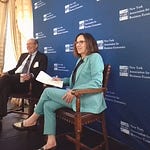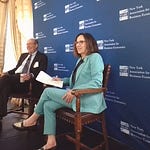If achieving a soft landing is the Holy Grail of Jay Powell-led monetary policy, Steve Blitz is an Oracle of Delphi warning the Federal Reserve Chair and his followers of what could go awry. The Fed has taken its first big step on the path to lower interest rates as it shifts its focus from inflation, which the majority of officials see on a steady path to its 2%, to the labor market which many worry could keep weakening and lead to recession if they don’t cut rates now and keep cutting them.
Steve sees a risk the Fed achieves no landing at all.
”What if there is no recession?,” he asks. “What if there's no real slowdown from here, and that the unemployment rate stays in this four, to four-and-a-half percent range? 4 and a half percent range, and we continue to have positive payroll growth, which also means you have positive income growth…in real terms?”
”Because, if you remember, inflation is coming down all right, and inflation rarely comes down, if ever, into a full employment economy. So consumers are getting a real dollar boost,” he explains. “So the question is, if I'm lowering the funds rate into this environment, is inflation really going to stay this low forever, and or does inflation start to respond in the other direction?”
”And I think that's what I mean by the real risk being…no landing at all, that the economy just continues to grow,” he says, and the appropriate funds rate ends up being higher than the 4% - or even higher above the 3% - many are looking for now.
The consumer is one big reason why Steve sees does not see a recession in the works. He points out that the latest Personal Income and Spending report showed signs the U.S. consumer is still going strong. Consumer discretionary spending - the purchases we make that are outside of the necessities we must buy like food, clothing and shelter - is rising above trend at a more than 3-1/4 % year-over-year rate.
”It’s hard for me to look at that pace of spending and sit there and say a recession is about to occur,” he says. “You know that raises the risk for the Fed of the No Landing scenario.”
Steve still expects the Fed to go full speed cutting the federal funds rate to 4%, which he sees as “a reasonable place to stop to stop and see what’s going on.” Whether or not they stop there or go to the 3% (rate) that the market has priced in is really going to depend on what the data looks like over the next several months, whether inflation is stalling out, is the economy showing resilience.
”And I think they could argue at that 4% is the right number at that point in time,” he says, adding that the No Landing scenario comes with the important caveat “that payroll growth remains positive.”
Steve says the Fed may risk repeating the mistake it made in the late 1960’s when it raised rates to bring down inflation, then started cutting rates then too soon and had to reverse course and start raising them again. ”I think this is the historic analog that's really not fully appreciated.”
“We had strong growth in government spending, and you had a fed that was easing, and then it had to tighten because inflation was going up… And then, as it started, inflation started to bend down, they backed away too soon…because they didn't want a recession to occur, and initially that was under (President) Johnson,” he explains.
“Then they got a small recession in 1969 when (President) Nixon came in, but they immediately reversed themselves, and before you knew it you were growing afterwards with a higher inflation rate and you never really got that inflation out of the system,” especially after the Bretton Woods System collapsed and took the dollar with it.
”The risk is, the Fed's doing the exact same thing. Inflation's coming down. They're tight, but they're now… already backing away, and if there's no landing they're backing away too soon,” he says.
“We don't really know. But I do know this, that if we don't squeeze that inflation out of the system it comes back faster…now like then you don't have that overhang of debt that's going to keep people from spending. You have the opposite,” Steve notes.
For now he expects the Fed to do the “prudent” thing.
”I think the funds rate is too high at the moment. Before they cut the 50, it was too high, and and it did need to come down. Now, I think it is imprudent of them to believe that the correct trajectory is to run through 4% and to get down to 3.
”But I think that second part of the that second 100 basis points will really be determined by how the data roll out over the next several months and and we'll see…If if the data tells them that they should stop at 4, that's fine, but you still leave open the question if the economy shows resilience, and coming back, that maybe their estimation of where the neutral real rate is too low.”
There’s a lot more to Steve’s analysis of how the No Landing is likely to unfold, and why there has been so little pushback among “the chattering classes” to what he calls the Fed’s “prescribed Goldlocks scenario.” So dive in now and hear and see what he has to say.
Steve Blitz is Managing Director and Chief U.S. Economist at Global Data TS Lombard. He joined the company in 2017. His professional experience as economist and portfolio manager began in the late 1970s.
It includes econometric modelling at Data Resources Inc., creating interest rate and FX derivatives strategies at Salomon Brothers, managing US and global fixed-income portfolios at OFFITBANK, being global head of fixed-income at Lazard Asset Management and, more recently, as Chief Economist at M Science he developed “big data” to underpin his analysis of the economy, central bank policies, and capital market pricing.













Share this post